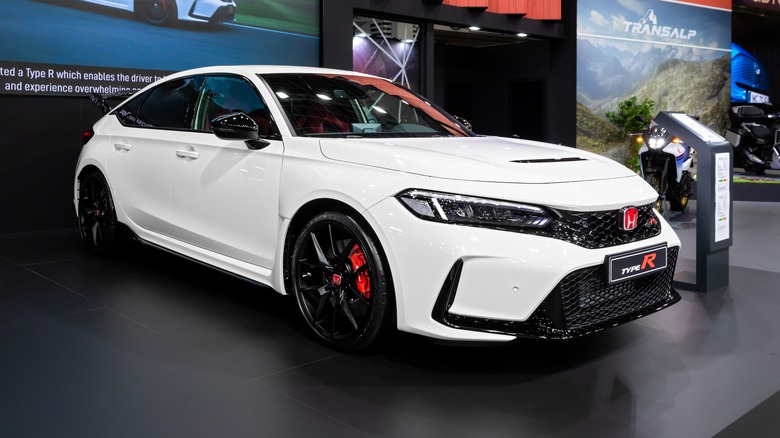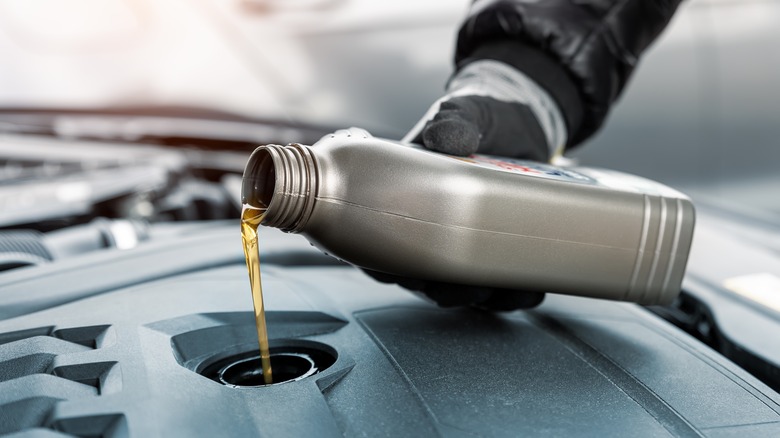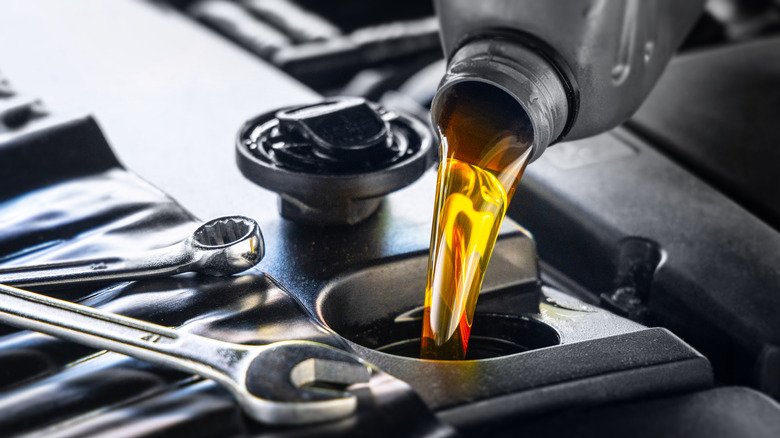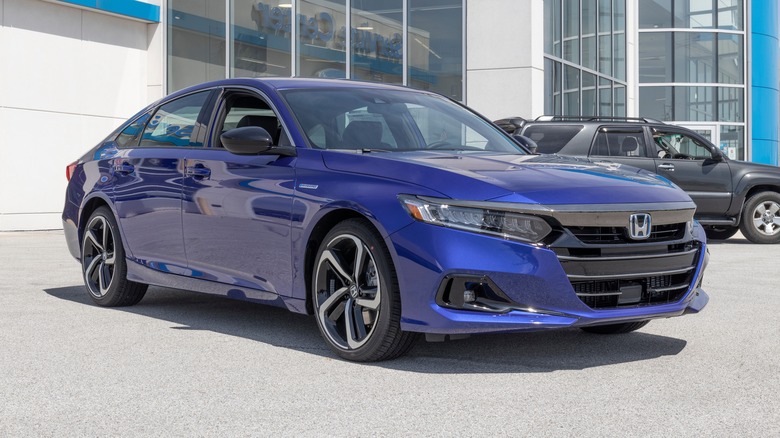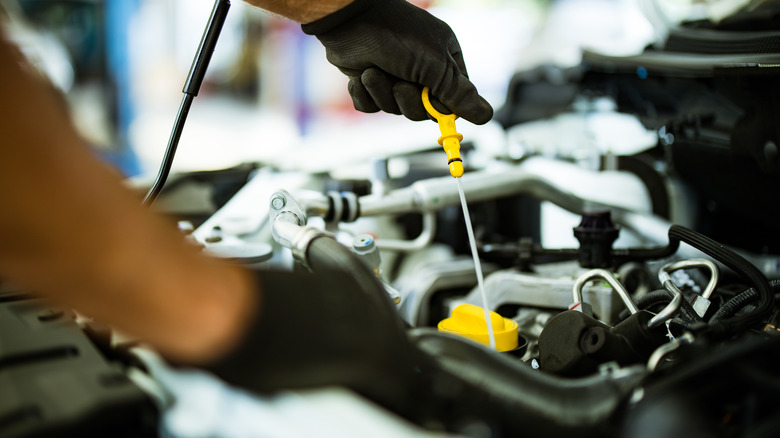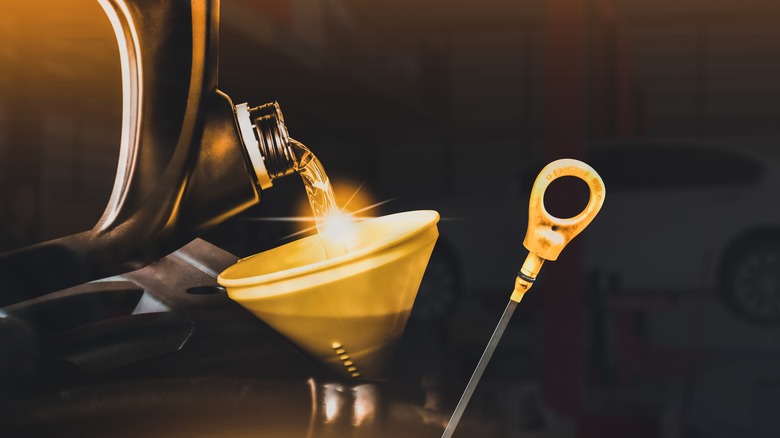How To Choose The Best Oil To Use In Your Honda
Honda is one of the most well-known and reliable car brands. The brand sells millions of cars per year, and that's not counting Honda's excellent motorcycles. As such, there are a bunch of Honda owners out there and not all of them may know the basics about oil. Oil is the lifeblood of your car and without it, the car is 100% certain to break down. No matter how reliable a car is, you still need to change the oil to keep it running smoothly.
The only hard part is that Honda has been around for decades, so there are a lot of different Honda vehicles. Fortunately, Honda has engineered their vehicles to run on standard oil types that are commonly available. You won't need to buy an exotic oil or look for a weird viscosity rating. Honda doesn't implement any strange oil pan placement or behaviors. They're one of the easiest car brands to service yourself, and there are plenty of Honda dealerships — along with independent mechanics — that can handle them.
So, let's get down to brass tacks. Most modern Honda cars use the same type of oil. With the exception of the S2000, which takes 5W-30, almost every Honda built after 2003 takes either 0W-20 or 0W-25. (We'll get into the specifics later.) There is a lot to know about how oil works in a Honda, especially if you're a little newer to "car stuff."
A quick primer on oil viscosity
Motor oil tends to be differentiated by its viscosity. In most cases, you'll see oil referred to by its viscosity rating. The rating is also referred to as the oil weight, and the terms are used interchangeably. In general, most modern cars, trucks, and SUVs use multi-grade motor oil. You'll see this written as something like 0W-20 or 5W-30. There are single-grade oils, such as 10W or 20W, but it's rare to see those used in cars. Most folks put them in lawnmowers, chainsaws, and similar equipment.
Here's what those numbers mean. The first number is the oil's viscosity rating when the engine is cold, meaning that it hasn't been started yet. The second number is the oil's viscosity rating when the engine is fully warmed up. Finally, the "W" that's almost always in the middle stands for "Winter", and it denotes that the oil is safe to use at winter temperatures. Thus, a 0W-20 oil means that it's at a "0" viscosity when it's cold, becomes a "20" viscosity oil when it's warmed up, and it can be used in the winter.
The final piece to the puzzle is understanding what needs to happen. In general, we all want thinner oil when it's cold so the engine can get properly lubricated as quickly as possible. Then, as the car warms up, you want the oil to thicken because thicker oil protects the engine better from wear. Thus, a 0W-20 oil is very thin when it's cold and thickens up to a 20 rating once it warms up. By contrast, a 5W-20 oil is slightly thicker than 0W-20 oil when it's cold but is the same viscosity once the car reaches operating temperature.
A quick primer on oil types
In addition to oil weights, there are three main types of oil that you can buy. They include conventional oil, synthetic blend, or full synthetic. Essentially, the difference between them is how many additives and other chemicals are present. For the record, full synthetic oil is not fake oil. It still uses crude oil as a base, but it's more heavily processed with additional additives and chemicals to aid in performance. The myth that synthetic oil isn't real oil is false. It is real oil.
Conventional oil is essentially crude oil refined for use in car engines. You don't see conventional oil used much in cars these days. It tends to be heavier and less resistant to extreme weather. Only older cars still use conventional oil, and it's not recommended, especially if you live in climates where winters are cold. Next, there is synthetic blend oil. This is essentially just a mix of cheaper conventional oil and full synthetic. It performs better and keeps your engine cleaner than conventional oil but is much less expensive than full synthetic.
Full synthetic oil is chemically engineered with additional chemicals, along with having fewer impurities than conventional oil. That allows full synthetic oil to work better at extreme temperatures, resist degradation better, and keep your engine cleaner. Variants of full synthetic are what most car brands recommend that you use. Honda uses what it calls Ultra Full Synthetic Oil. Honda says it developed this oil specifically for Honda engines and it's typically only available at Honda dealerships.
Why you should get your oil changed
Oil, like most other substances on earth, degrades as it ages. Heating it up and cooling it down over and over again accelerates this process. This gradual degradation isn't noticeable on a day-to-day basis, but it's not terribly difficult to tell the difference between old, dirty oil and new, fresh oil. A good extreme case is to find a video where someone is changing the oil on a car that hasn't been changed in a few years. It's essentially sludge at that point, which makes it easy to tell apart from fresh oil visually.
Aging oil can have a variety of negative effects if not taken care of in a timely manner. For starters, old oil is worse at lubrication than fresh oil, so your engine won't function as well. It may not be noticeable by listening or by driving, but you'll get slightly worse fuel economy, and your engine may get a little warmer than it normally does. It's not unusual to feel like the car feels better to drive after a fresh oil change, especially if it's been a while.
Over the long term, much worse things can happen if you don't change your oil regularly. They can include faster engine wear, which leads to more frequent breakdowns and sooner-than-expected engine failure. Additionally, for newer vehicles at least, car makers will void your warranty if you don't get regular oil changes because the companies don't feel like they should fork out for warranty repairs when the failure could've been caused by old oil. It's not cool, but that's how it works.
What kind of oil does Honda recommend I use?
The first place you should look to see what type of oil you need is your owner's manual. If you don't have one, Honda lets you download a PDF version for free on their MyGarage website. Simply enter your car's year, model, and trim, and the site will find your manual. There's an alternate method where you can use your VIN as well. The owner's manual will list the right type of oil for your Honda.
For newer Hondas, this is actually pretty easy. If you have a modern Honda from the last two generations, Honda recommends that you use 0W-20 oil. That works for the Accord, Ridgeline, Pilot, and the rest of their lineup. So, for example, if you own a 10th-generation or 11th-generation Honda Accord, every variant of it from the hybrid to the 2.0T uses 0W-20 oil. The same goes for every other vehicle that Honda sells.
If your vehicle is older than that, it may get a little more complicated. Most vehicles Honda made from 2003 to 2012 use 5W-20 or 0W-20 while most Hondas made in the 1990s use 5W-30. Hondas made in the 1980s usually used 10W-30 oil. You'll want to search for your specific model to get exact details, but it's very rare to see a car need something lighter than 0W-20 or heavier than 10W-30 from Honda.
In terms of oil type, Honda recommends its own Ultra Full Synthetic blend, which you can usually only get at dealerships. Barring that, you'll be fine with a full synthetic oil provided that it's the correct viscosity.
Do I have to get my oil changed at a Honda dealership?
Strictly speaking, no you don't. Honda prefers that you use the dealership because it helps out the dealership financially, and Honda can use the type of oil they believe works best for your car. That said, there are some benefits to going to a dealership. Generally speaking, the dealership will have all of the proper fluids, from oil to transmission fluid to brake fluid. There's no guesswork at a dealership, and you know exactly what's going into your car, even if it costs extra. Plus, a dealership will take care of things like recalls if your car has them, usually free of charge.
You don't absolutely have to go to a dealership, though. As long as the correct type of oil is going into your Honda, it will still drive like it's just had a fresh oil change. Mechanics and oil change shops have databases that tell them what kind of oil to use on your Honda, and if not, they know how to find that information. It's extremely rare for a mechanic to put the wrong oil in your car.
In either case, the most important part is ensuring that the proper oil is going into your car. If you're not using Honda oil, it should be a full synthetic oil in the case that your Honda is newer. There is also high-mileage oil that you can put in your older Honda to help it work its best given its advanced age. If your mechanic is reliable, they should be able to help you decide if regular full synthetic or high-mileage oil is right for you.
How often should I get my Honda's oil changed?
For newer Hondas, the car maker recommends 7,500 to 10,000 miles, assuming that you're using Honda's oil. If you use a different type of oil, you may want to stray closer to 7,500 than 10,000. This is another question your owner's manual can cover so we recommend looking in there for your specific model. Modern Hondas also come with a feature called Maintenance Minder that will remind you to get your oil changed once the car has determined that your oil is too old. It usually determines your oil life by the number of miles you've driven and how long it's been since your last oil change.
For older models and models that don't have Maintenance Minder, the rules are mostly the same. Check your owner's manual to see how much mileage or how much time between oil changes. You'll just have to remember to do it manually since the car's computer won't remind you. However, it is also conventional wisdom that older cars don't use oil as well as newer cars, so you should plan for oil changes a little more frequently.
The old rule of thumb is every six months or 3,000 miles, whichever comes first. You can follow that advice today if you really want to, but modern oil is a lot better at lubricating newer engines for longer than old oil, so you would be effectively wasting money if you adhered to that schedule on a new car. If your Honda is old or has very high mileage, then 3,000 miles is still a good rule of thumb to follow.
What you should know about mixing oil viscosities
You can, in fact, mix oils with different viscosities. The differences between something like 0W-20 and 5W-20 isn't vast, so there is little harm if you need to top off your oil and you can't find the exact same type available. That shouldn't happen very often, but gas stations out in the boonies aren't known for stocking an entire lineup of motor oil. Adding slightly thicker or thinner oil won't affect your car so much that it'll have problems. It's better to have a slightly different oil in your car than to not have oil in your car at all.
However, we don't recommend using the wrong oil over a long period of time, nor do we recommend using the wrong oil viscosity for oil changes. There is a difference between topping up in an emergency with something slightly different and running your car on completely different oil all the time. Honda knows what kind of oil its engines need, and using a different oil weight has the potential to accelerate engine wear and potentially cause breakdowns later in the vehicle's life. It's not recommended.
Check your oil levels consistently
Finally, let's discuss how often you should check your oil levels. A lot of people never get into this habit, and have no idea how much oil is in their car at any given moment. It's definitely in your best interest to check your oil at least once a month. A lot of people check theirs almost every time they fill up their gas tank. It's not like there's anything else to do while refueling.
There are a few reasons why this is a good idea. A lot of engines burn oil alongside the fuel during combustion, so you may need to add more oil occasionally to replace what's been lost. On the other end of the spectrum, a common issue with modern turbo engines is fuel dilution where gasoline gets into your oil pan. This is easily recognizable if you regularly check your oil levels. You may find that you have way more oil than you expected, and your oil will smell like gasoline. In either case, whether it's too high or too low, it's better to know about such issues sooner rather than later.
For Hondas, this is especially true. The 1.5-liter turbos the company puts in their fifth-generation Honda CR-Vs have a history of fuel dilution issues. You can usually fix these yourself by driving the car at its operating temperature for 20 to 30 extra minutes to burn off the excess fuel. However, the point is that issues like this can happen to anyone, even a Honda owner.
